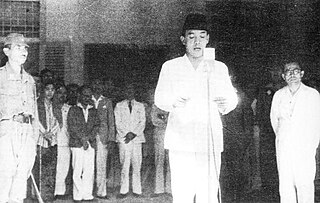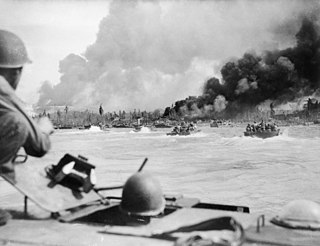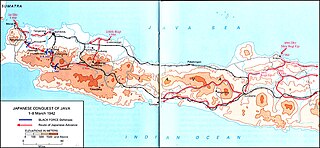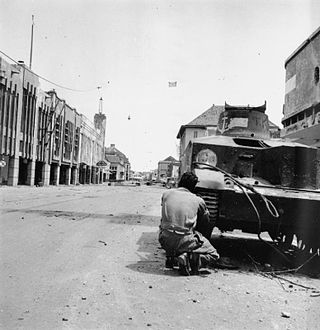
The Indonesian National Revolution, also known as the Indonesian War of Independence, was an armed conflict and diplomatic struggle between the Republic of Indonesia and the Dutch Empire and an internal social revolution during postwar and postcolonial Indonesia. It took place between Indonesia's declaration of independence in 1945 and the Netherlands' transfer of sovereignty over the Dutch East Indies to the Republic of the United States of Indonesia at the end of 1949.

Padang is the capital and largest city of the Indonesian province of West Sumatra. It had a population of 833,562 at the 2010 Census and 909,040 at the 2020 Census; the official estimate as at mid 2023 was 942,938 - comprising 473,089 males and 469,849 females. It is the 16th most populous city in Indonesia and the most populous city on the west coast of Sumatra. The Padang metropolitan area is the third most populous metropolitan area in Sumatra with a population of over 1.7 million. Padang is widely known for its Minangkabau culture, cuisine, and sunset beaches.
The Battle of Ambon occurred on Ambon Island in the Dutch East Indies, as part of the Japanese offensive on the Dutch colony during World War II. In the face of a combined defense by Dutch and Australian troops, Japanese forces conquered the island and its strategic airfield in several days. In the aftermath of the fighting, a major massacre of many Dutch and Australian prisoners of war by the Imperial Japanese Army (IJA) followed. Following the war, many of the IJA personnel were tried for war crimes.

The Battle of Balikpapan was the concluding stage of Operation Oboe, the campaign to liberate Japanese-held British and Dutch Borneo. The landings took place on 1 July 1945. The Australian 7th Division, composed of the 18th, 21st and 25th Infantry Brigades, with a small number of Netherlands East Indies KNIL troops, made an amphibious landing, codenamed Operation Oboe Two, a few miles north of Balikpapan. The Allied invasion fleet consisted of around 100 ships. The landing had been preceded by heavy bombing and shelling by Australian and US air and naval forces. The Allied force totalled 33,000 personnel and was commanded by Major General Edward Milford, while the Japanese force, commanded by Rear Admiral Michiaki Kamada, numbered between 8,400 and 10,000, of which between 3,100 and 3,900 were combatants. After the initial landing, the Allies secured the town and its port, and then advanced along the coast and into the hinterland, capturing the two Japanese airfields. Major combat operations concluded around 21 July, but were followed by mopping-up operations, which lasted until the end of the war in mid-August. Australian troops remained in the area until early 1946.

The Battle of Java was a battle of the Pacific theatre of World War II. It occurred on the island of Java from 28 February – 12 March 1942. It involved forces from the Empire of Japan, which invaded on 28 February 1942, and Allied personnel. Allied commanders signed a formal surrender at Japanese headquarters at Bandung on 12 March.

The Battle of Surabaya was a major battle in the Indonesian National Revolution fought between regular infantry and militia of the Indonesian nationalist movement and British and British Indian troops against the re-imposition of Dutch colonial rule. The peak of the battle was in November 1945. The battle was the largest single battle of the revolution and became a national symbol of Indonesian resistance. Considered a heroic effort by Indonesians, the battle helped galvanise Indonesian and international support for Indonesian independence. 10 November is celebrated annually as Heroes' Day.

Merauke Force was an Australian-led military force of World War II which was responsible for defending Merauke in Dutch New Guinea from Japanese attack amidst the Pacific War. The force was established in late 1942 and was disbanded at the end of the war, having never seen combat. The Japanese attack did not eventuate and from mid-1944 the force was progressively drawn down and its assigned units redeployed to Australia or elsewhere in the Pacific. At its height, Merauke Force included troops from Australia, the Netherlands East Indies and the United States, as well as several squadrons of aircraft, including a joint Australian-Dutch fighter unit.

This is a timeline of the events that stretched over the period of late World War II, its conclusion, legal aftermath, with the inclusion of the Cold War, from January 1945 to December 1991.

Suryadarma Air Force Base is one of the Indonesian Air Force bases on Java. Formerly known as Kalijati Airfield, it is located in the village of Kalijati, in the kabupaten of Subang in West Java.

In Dutch historiography, Bersiap refers to the violent and chaotic beginning of the Indonesian National Revolution following the end of World War II in Asia. In Indonesia, the term Berdaulat ("Sovereign") is also used for this transitional period. It began after Sukarno's proclamation of Indonesian Independence on 17 August 1945 and culminated during the power vacuum between the withdrawal of Japanese occupational forces and the gradual buildup of a British military presence, before the official handover to a Dutch military presence in March 1946.

Suharto was the second President of Indonesia, having held the office for 31 years from 1967 following Sukarno's removal until his resignation in 1998.

The Battle of Medan, known locally as the Battle for the Medan Area took place between Allied forces and the Indonesian Army in Medan, North Sumatra, and its surrounding area during the Indonesian National Revolution.

Andi Abdullah Bau Massepe was a Bugis-Indonesian nobleman who initiated attacks against Dutch forces during the National Revolution. He was the son of Andi Mappanyukki. On 9 November 2005, he was conferred the title of National Hero of Indonesia posthumously.

The Semarang offensive is composite of the Battle of Ambarawa, Magelang offensive, Battle of Ungaran or Ungaran offensive, and Semarang offensive proper. This major battle took place between the recently created Indonesian Army and the British Army with the Dutch forces that occurred between 20 October 1945 and 2 March 1946 in Semarang city, Semarang Regency, and Magelang Regency in Central Java, Indonesia. Perhaps the most successful Indonesian offensive of the Indonesian Revolution, this offensive tightened British and Dutch control from the Magelang and Semarang metropolitan areas to only Semarang city. In modern times, 15 December is celebrated as the Indonesian National Infantry Day.

Said Rasjad served as acting mayor of Padang, bupati of Agam, and regent of Padang Pariaman.

The People's Security Agency, commonly abbreviated as BKR, was an Indonesian government agency established to undertake the task of maintaining security together with the people and the state offices. The BKR was formed by the Preparatory Committee for Indonesian Independence (PPKI) in its session on 22 August 1945 and announced by President Sukarno on the next day.
The Kolaka incident, known locally as the 19 November incident, was an ambush of a Dutch military convoy near Kolaka, Southeast Sulawesi on 19 November 1945, during the early months of the Indonesian National Revolution.

The Battle of Bojong Kokosan was fought on 9-12 December 1945 in the Sukabumi Regency of West Java as a part of the Indonesian National Revolution, when a British army convoy carrying prisoners of war and internees to Bandung was ambushed by local Indonesian freedom fighters near Cicurug. The conflict is considered one of the first instances of de facto recognition of the Republic of Indonesia by the Western Allies, as the convoy's negotiator was able to successfully secure safe passage to Bandung on the 12th.
The Battle of Bali Strait marked the first amphibious battle conducted by the Indonesian Navy in the Bali Strait. Fought on 5 April 1946, the engagement pitted the early Indonesian Navy against the much better equipped Dutch Royal Navy. The battle concluded with a significant victory for the Indonesian forces, cementing its place in the history of Indonesia's struggle for independence.
Battle of Palembang or Battle of Five Days Five Night was an incident of resistance by the Indonesian army against attacks by Dutch army troops NICA which occurred in Palembang for five consecutive days from 1 to 5 January 1947.
















